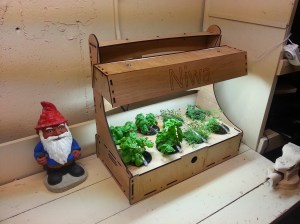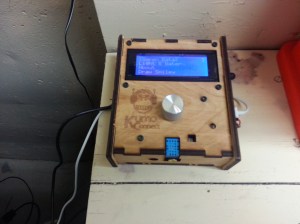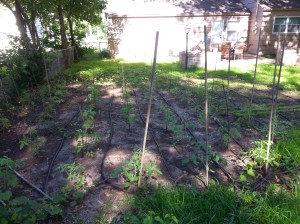 I ran into a guy at Maker Faire Kansas City who I used to scoop ice cream with twenty years ago. We were slinging frozen dairy at a Baskin Robbins in a dying suburban strip mall that had a one-hour photo booth in the parking lot. It was just far enough away from our doorstep that dotting its backside with the hard-frozen ice cream balls that had been scooped and then not always accidentally dropped into the depths of the freezer was challenging. This guy, [Blake], kept a hockey stick hidden in the back room especially for this purpose. I never could get them to fly that far, but he was pretty good at it.
I ran into a guy at Maker Faire Kansas City who I used to scoop ice cream with twenty years ago. We were slinging frozen dairy at a Baskin Robbins in a dying suburban strip mall that had a one-hour photo booth in the parking lot. It was just far enough away from our doorstep that dotting its backside with the hard-frozen ice cream balls that had been scooped and then not always accidentally dropped into the depths of the freezer was challenging. This guy, [Blake], kept a hockey stick hidden in the back room especially for this purpose. I never could get them to fly that far, but he was pretty good at it.
I hadn’t seen him since those days, and there he was manning a booth at Maker Faire. He looked quite professional, showing no hint of the mischief from those days of ice cream hockey. His booth’s main attraction was Niwa, a connected indoor garden. Having spent four years living and working in Japan after college, [Blake] did not choose this name arbitrarily: ‘niwa’ is Japanese for ‘garden’. He loves Hackaday and was more than happy to share his story.

Connecting with Nature
[Blake] is an avid gardener, but his wife does not share this passion. A few years ago, he took a new job that required travel on an almost weekly basis, which meant big trouble for his plants. Unfortunately, he couldn’t find what he wanted to ensure they were taken care of. You know what comes next: he decided he would design his own system. However, he had no experience with electronics.
Enter the Sparkfun Arduino Inventor’s Kit. Once he achieved Hello, World, he was unstoppable. After a couple of months, a lot of googling, and several prototype iterations, he arrived at the current design.
 Niwa does pretty much everything you’d want a connected garden to do: it measures the soil moisture, relative humidity, ambient light, temperature, and barometric pressure. Inside the controller is a custom ATMega328 shield that can work as a standalone or on top of a Pi for web connectivity and control.
Niwa does pretty much everything you’d want a connected garden to do: it measures the soil moisture, relative humidity, ambient light, temperature, and barometric pressure. Inside the controller is a custom ATMega328 shield that can work as a standalone or on top of a Pi for web connectivity and control.
He can set it to water on a schedule through Google calendar, but he prefers to do it himself from his phone. The Pi sends a sensor data breakdown the Xively web service so he can check out the graphs from his hotel room. Niwa doesn’t use anything weird or difficult to source, just good ol’ ebay sensors like a photocell, the DHT-11, and a BMP-085 for barometric pressure data.
Garden Party
 Once he got Niwa up and running, he expanded automation to his larger indoor garden as well as his 25’ x 25’ outdoor vegetable garden. The indoor gardens use aquarium pumps and buckets for watering. Outside, the vegetables thrive in rows divided by soaker hoses that are fed from the spigot and controlled with a solenoid valve. All three gardens have gnome guardians with weather sensors and a 2.4GHz radio so they can share intel. [Blake] has plans to integrate weather monitoring that would have the system check rain predictions and adjust watering accordingly.
Once he got Niwa up and running, he expanded automation to his larger indoor garden as well as his 25’ x 25’ outdoor vegetable garden. The indoor gardens use aquarium pumps and buckets for watering. Outside, the vegetables thrive in rows divided by soaker hoses that are fed from the spigot and controlled with a solenoid valve. All three gardens have gnome guardians with weather sensors and a 2.4GHz radio so they can share intel. [Blake] has plans to integrate weather monitoring that would have the system check rain predictions and adjust watering accordingly.
Home of the Future
Once he had all three gardens running smoothly, [Blake] wanted to automate all the things. His blinds could open and close based on the light outside. His dog could be fed automatically. The thermostat could make decisions; the garage door could close itself if left open. Did the mail come? Did the doorbell ring while no one was home? No reason he couldn’t find out, and from almost anywhere in the world.
Then [Blake] saw a business opportunity. He brought in a few people to help with software development, marketing, manufacturing, and design, and Kumo Connect was born. They have built many prototypes including an automatic dog feeder, smart thermostat, and garage door unit. All of these are standalone units, but are able to talk to each other. Other designs they have built include automated window blinds, safes, and desk locks.
[Blake] and his team are getting close to releasing Niwa as a commercial product. Either way, they plan to publish all the CAD designs and code once everything is ready for prime time. For now, you can visit their site and register for updates.
[Blake]’s advice to anyone who wants to explore open hardware and software, spearhead a startup, or anything in between is simple: surround yourself with people smarter than you. In particular, he is grateful for the support of his teammates and all his friends at Hammerspace.
[Photo credit: Back to the Future, Universal Pictures and Amblin Entertainment]















All these people with access to laser cutters and other horribly expensive tools.. Is there ANY sources for affordable Laser cutters out there? likes under $500?
Well, I got a ebay “K40” style laser locally for $500 used on Kijiji. For my purposes, it took another $500 + a lot of time to make it do what I wanted, but I have a lot of fun with it now. It was in working condition for $500, but could really only engrave with the built in electronics. They also sell new one on ebay/alibaba for $599 + shipping but of course buyer beware.
I have the same style. Was pretty useless if not dangerous in the stock configuration.
I second the K40 laser. I just bought one at work ($560 w/ shipping on ebay) to cut out intricate shapes of a special film, and it works decently. Its not the belle of the ball but it works! Yes it did require a bit of tinkering. The buttons on it are flimsy and will probably be replaced soon. One of the limit switches on the y-axis was out of alignment so when I first ran it, the limit flag took the limit switch right off its mount and then slammed into the frame. And yeah, the Chinglesh manual was useless.
OH WELL! Even with needing a bit of time, effort and cash to fix/improve little things, it was still a great purchase in my mind. I think my laser cutter is far from useless or dangerous but everyone’s results vary i guess.
A similar laser cutter was suggested to me by a coworker. This laser cutter used what appeared to be the same chasis and probably the same laser. It has more bells and whistles such as an adjustable height platform but costs $2000. With the $1400 I saved I can buy an inexpensive 3D printer!
Dont discount cheap systems too much – They will typically perform their intended job adequately in one way or another, provide a base for upgrading and customizing to fit your specific needs, and most importantly provide a learning experience and a point of entry.
Quality probably varies a lot in these units then. The mechanical issues I have had have been similar to yours, but the controller hardware/software have been large issues. Mainly the following:
1. Randomly home while cutting, then repeatedly backing off and ramming into the home position.
2. Turn on the laser while cutting and then travel across the work surface.
I’ve since replaced the controller with a smoothieboard though.
I came to say nice article, great spelling! Look forward to more from the cornbreadninja!
Thanks! Can I get some brownies? :)
I request a rematch on the ice cream driving range. I hope you have been practicing over the last 20 years. I’ll bring the hockey stick and rock hard ice cream balls… you bring your A game Kristina!